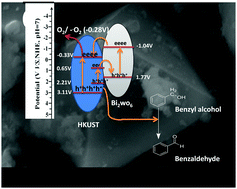Enhanced d–d transitions in HKUST/Bi2WO6 nanocomposite mediated visible-light driven selective conversion of benzyl alcohol to benzaldehyde†
Abstract
Enhanced solar absorption mediated by the direct involvement of the d–d transition in a suitably selected HKUST/Bi2WO6 photocatalyst is reported towards the efficient and selective conversion of benzyl alcohol to benzaldehyde. The selected catalyst possesses a suitable band alignment with a filled d band (2.21 V and 0.65 V) perfectly placed between the valence band (1.77 eV) and conduction band (−1.04 eV) of Bi2WO6. This ideal band alignment mediates facile charge mobility from HKUST to Bi2WO6 and effects an enhancement in the otherwise Laporte forbidden d–d transitions besides suitably red shifting the existing LMCT (ligand to metal charge transfer) band from 3.4 eV to 2.7 eV. The enhanced d–d transitions along with the redshifted LMCT in the HKUST/Bi2WO6 composite effect an efficient oxidative photoconversion of benzyl alcohol to benzaldehyde with a conversion efficiency of 85% and selectivity of 95%. The photocatalytic performance thus achieved is far superior to the performance of the individual HKUST (conversion = 17%; selectivity = 99%) and Bi2WO6 (conversion = 29%; selectivity = 90). The performance of HKUST/Bi2WO6 is found to be comparable with that of the best catalysts reported in the literature for this conversion.



 Please wait while we load your content...
Please wait while we load your content...